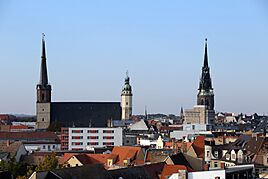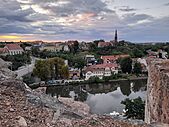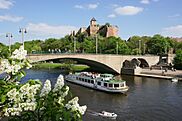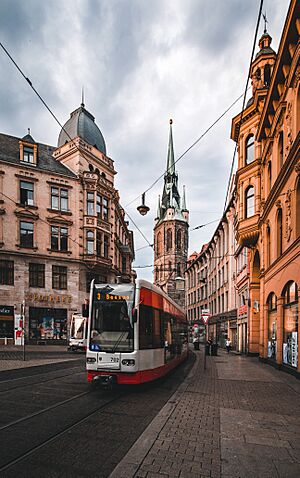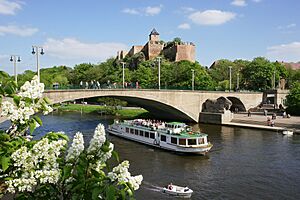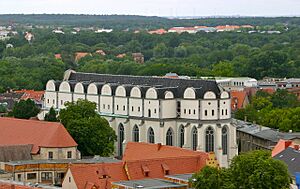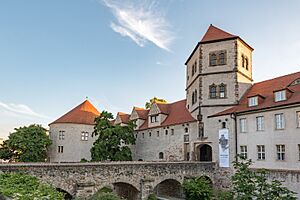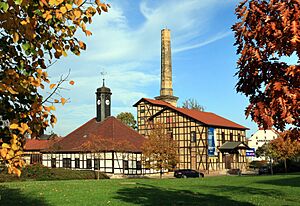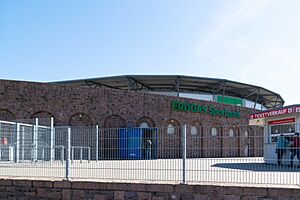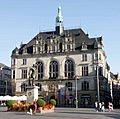Halle (Saale) facts for kids
Quick facts for kids
Halle (Saale)
|
|||
|---|---|---|---|
|
|
|||
|
|||
| Country | Germany | ||
| State | Saxony-Anhalt | ||
| District | Urban district | ||
| Elevation | 87 m (285 ft) | ||
| Population
(2022-12-31)
|
|||
| • Total | 242,083 | ||
| Time zone | CET/CEST (UTC+1/+2) | ||
| Postal codes |
06108-06132
|
||
| Dialling codes | 0049345 | ||
| Vehicle registration | HAL | ||
Halle (Saale), often called just Halle, is the biggest city in the German state of Saxony-Anhalt. It's one of the largest cities in what used to be East Germany. About 244,000 people live here, making it a bit bigger than Magdeburg, the state capital.
Halle is located in the southern part of Saxony-Anhalt. It sits on the River Saale, which is a major river in Germany. The city is also part of a larger area called the Central German Metropolitan Region. This region includes nearby Leipzig, forming a busy center for business and education. The Leipzig/Halle Airport is located between these two cities.
Halle is a very important place for learning and business in Central Germany. The Martin Luther University of Halle-Wittenberg is one of Germany's oldest universities. It has campuses in Halle and Wittenberg. The university hospital in Halle is the biggest hospital in the state. Also, the German National Academy of Sciences Leopoldina, a top science group, is based here. Halle is also a big radio center, with the Halle Radio Tower being Germany's second-tallest lattice tower.
The Halle tramway system is one of the largest in Germany. Halle (Saale) Hauptbahnhof is a key train station. The Saale-Elster Viaduct, which is Germany's longest bridge, passes through Halle.
Halle is famous for some special things. The Nebra sky disc, an ancient artifact showing stars, is displayed at the Halle State Museum of Prehistory. Also, the famous composer George Frideric Handel was born here. His childhood home, the Handel House, is now a music museum.
Contents
Exploring Halle's Location
Halle (Saale) is in the middle of Germany. It lies in the southern part of the state of Saxony-Anhalt. The city is built along the River Saale. This river flows through the flat lands around Halle. It also drains water from the nearby state of Thuringia.
Leipzig, another big German city, is only about 35 kilometers away. Halle covers an area of about 135 square kilometers.
Halle's Weather
Halle has a mild climate, meaning it doesn't get too hot or too cold. It's similar to an oceanic climate, which means it gets rain throughout the year. Sometimes, it can be a bit dry, but usually there's enough rain for plants and trees to grow well. Extreme heat is rare, with temperatures almost never reaching 40 degrees Celsius. This weather helps farming and keeps the city green.
Halle's Story: A Look Back
How Halle Got Its Name
Halle's early history is all about salt. The name of the River Saale comes from an old German word for salt. People have been getting salt from the ground in Halle for a very long time, even since the Bronze Age (over 2,500 years ago!).
For a while, from 1965 to 1995, the city's official name was Halle/Saale.
From Old Times to New Changes
Halle was first officially mentioned in the year 806. In the 900s, it became part of the Archbishopric of Magdeburg. This lasted until 1680. Then, it joined the Margraviate of Brandenburg as the Duchy of Magdeburg.
In the 1500s, Halle was important during Martin Luther's Reformation. This was a big change in the Christian church. The city also became a member of the Hanseatic League by 1281. This was a powerful group of trading cities.
Halle became a center for a religious movement called Pietism. This movement focused on strong faith and helping others. King Frederick William I of Prussia liked this movement. It encouraged people to be more loyal to the king. By the 1740s, Halle had many orphanages and schools. These schools were some of the first to offer a "modern education." The Pietists also worked to help poor people.
In 1806, during a war, French and Prussian soldiers fought in the Battle of Halle. The fighting moved through the city streets. In 1815, Halle became part of the Kingdom of Prussia.
Halle During World War II
During World War II, Halle had factories that made aircraft. There was also a factory that produced chemicals.
Near the end of the war, Halle was bombed twice in March 1945. These attacks caused damage and destroyed many buildings. Over 1,000 people lost their lives. Important places like the Market Church and the Old Town Hall were hit.
On April 17, 1945, American soldiers arrived in Halle. The city was saved from more damage because a former naval officer, Felix von Luckner, helped arrange for the city to surrender peacefully. In July, the Americans left, and the city was taken over by the Red Army.
After the War: East and Unified Germany
After World War II, Halle was the capital of the Saxony-Anhalt region for a short time. Then, from 1949 to 1990, it was part of East Germany. During this time, it was the capital of the Halle district.
When Germany became one country again in 1990, Saxony-Anhalt was re-established as a state. However, Magdeburg became the capital, not Halle.
People of Halle
Halle has a population of about 238,000 people. It is the largest city in the state of Saxony-Anhalt. In the past, during the time of East Germany, Halle had many large industries. This meant lots of jobs. At that time, Halle was one of the most important cities in East Germany.
Halle's population was highest in 1991, with about 305,000 people. After Germany became unified, many industries closed. This caused some people to move away, especially to former West Germany.
Since 2015, the number of foreign residents in Halle has grown. Many refugees from countries like Syria have moved to the city.
Here are the top nationalities of foreign residents in Halle (as of March 31, 2022):
| Rank | Nationality | Population |
|---|---|---|
| 1 | 5,468 | |
| 2 | 4,330 | |
| 3 | 1,318 | |
| 4 | 1,174 | |
| 5 | 1,066 | |
| 6 | 1,033 | |
| 7 | 978 | |
| 8 | 843 | |
| 9 | 782 | |
| 10 | 721 |
Cool Places to See in Halle
Halle has many interesting places to visit!
- Halloren Chocolate Factory: This is Germany's oldest chocolate factory that is still making chocolate! You can visit and see how it's made.
- Giebichenstein Castle: This old castle was first mentioned in the year 961. It sits on a hill above the Saale river. Today, it has a museum and an art and design university.
- Moritzburg Castle: This newer castle was built between 1484 and 1503. It was once a home for archbishops. After being damaged in a war, it was partly rebuilt. Now, it's an art gallery.
- Market Square: This is the heart of the city. Here you'll find:
* Market Church of St. Mary: Built in the 1500s, this church has four tall towers. Two are called Blue Towers because of their dark blue roofs. The other two are connected by a bridge, which used to be a fire watch point. The church has a special death-mask of Martin Luther. * Roter Turm (Red Tower): This tall tower was built between 1418 and 1503. It's a famous symbol of Halle. Together with the church towers, it forms the "five towers" skyline. * Roland: This statue represents the city's freedom. The one you see today was made in 1719. * Monument to George Frideric Handel: A statue of the famous composer.
- Handel House: This is the house where composer George Frideric Handel was born. It's now a museum about his life.
- Wilhelm Friedemann Bach House: This was the home of composer Wilhelm Friedemann Bach. It is also a museum now.
- Old Market Square: Here you can see the Donkey's Fountain. It tells a story from a local legend.
- Francke Foundations: These are historic Baroque buildings. They include one of Europe's largest surviving half-timbered buildings.
- Stadtgottesacker: A Renaissance cemetery from 1557, designed like an Italian camposanto.
- Saline Museum: This museum teaches you about Halle's salt production. You can learn about the Halloren, who were the salt workers.
- Cathedral (Dom): This building was once a monastery church. It was later changed into a cathedral.
- Halle State Museum of Prehistory: This museum is where you can see the famous Nebra sky disk.
- Theatres: Halle has several theaters, including the Halle Opera House and the Thalia Theater, which is the only theater for children in Saxony-Anhalt.
- Parks and Gardens:
* Botanical Garden: Part of the Martin Luther University, this garden was started in 1698. * Reichardts Garten: A historic English garden from 1794. * Peißnitz Island: A popular island park. * Zoological Garden (Bergzoo): A zoo located on a hill.
- Dölauer Heide forest: This forest has ancient graves from about 2500–2000 BC.
Halle's Industrial Past
Salt, sometimes called white gold, was very important to Halle. It was taken from four special wells. The salty water, called brine, was boiled in simple houses to get the salt. The salt workers were called Halloren. They wore special uniforms with silver buttons. The famous Halloren chocolates are shaped like these buttons!
The Halloren Chocolate Factory was started in 1804. It's the oldest chocolate factory in Germany. You can see old documents and a special chocolate room there.
During the time of East Germany, Halle was a big center for the chemical industry. Large factories like Buna-Werke and Leuna were in the area. The city of Halle-Neustadt was built in the 1960s to house the many workers from these factories.
Science and Culture in Halle
The famous Baroque composer Georg Friedrich Händel was born in Halle in 1685. He lived here for the first 17 years of his life. His home is now a museum. Every June, Halle holds a Handel Festival to celebrate his music.
The University of Halle was founded in 1694. Today, it's combined with the University of Wittenberg and called the Martin Luther University of Halle-Wittenberg. Its medical school was started by Friedrich Hoffmann. The university's botanical garden dates back to 1698.
Halle is also home to the German Academy of Sciences Leopoldina. This is Germany's oldest and most respected science group. The city also has Germany's oldest Protestant church library, the Marienbibliothek, with 27,000 books. The Max Planck Institute for Social Anthropology, a big research center, is also in Halle.
Halle was a key place for Pietism, a religious movement. It helped start the Lutheran church in North America. Missionaries like Henry Muhlenberg were sent from Halle to Pennsylvania in the 1700s. He is known as the first leader of the Lutheran Church in America. His son, Frederick Muhlenberg, who was the first Speaker of the United States House of Representatives, also studied at Halle University.
The Silver Treasure of the Halloren is a special collection of silver and gold cups from 1266. You can sometimes see it at the Technical Museum Saline. There, you can also watch how salt was traditionally boiled. The State Museum of Prehistory displays the Nebra sky disk, an important Bronze Age discovery.
Halle Zoo helps with breeding programs for animals like the Angolan lion and the Malaysian tiger. Halle is also known for its many coypu (or nutria), which are rodents from South America.
Many famous writers and thinkers have been connected to Halle. These include Heinrich Heine, Joseph Freiherr von Eichendorff, and Novalis. The famous writer Johann Wolfgang von Goethe often visited his friend Johann Friedrich Reichardt in Halle.
The German-American painter Lyonel Feininger painted many famous pictures of Halle. One of his most well-known paintings, Die Türme über der Stadt (The towers above the city), shows Halle's skyline. This painting even appeared on a German postage stamp!
Getting Around Halle
Ludwig Wucherer helped make Halle a key railway center in Germany. In 1840, he opened the first train line connecting Magdeburg, Halle, and Leipzig. Over the next 20 years, more lines were added to places like Erfurt and Berlin.
Halle's public transport system is famous for its tram network. It had the world's first major electric tram line in a city, opened in 1891! Halle (Saale) Hauptbahnhof is the main train station.
Halle's importance for trains grew with the new Erfurt–Leipzig/Halle high-speed railway. Many high-speed trains between Berlin and Munich stop in Halle.
Leipzig/Halle Airport is an international airport. It serves both Leipzig and Halle. It's one of Germany's busiest airports for cargo flights. It also has many flights to European vacation spots.
Sports in Halle
Halle has a strong sports history. The football team Hallescher FC Wacker 1900 was important before World War II. Later, the team won East German championships in 1949 and 1952. Today, the club is called Hallescher FC and usually plays in the third division. A famous player from this club was Bernd Bransch, who played for East Germany many times.
The sports club SV Halle has produced many Olympic gold medalists and world champions. These athletes are often in water sports like swimming and rowing. For example, swimmer Kornelia Ender won four Olympic gold medals in 1976. The club's basketball teams also won many championships in East Germany.
Famous People from Halle
Halle is the birthplace or home of many notable people.
- Georg Friedrich Händel (1685–1759): A world-famous Baroque composer. He was born and grew up in Halle.
- August Hermann Francke (1663–1727): A Lutheran theologian who founded the Halle Orphan House.
- Friedrich Ludwig Jahn (1778–1852): A student at Halle University who is known as the "father of gymnastics" in Germany.
- Hans-Dietrich Genscher (1927–2016): A very important German politician. He was the Vice Chancellor and Foreign Minister for many years.
- Dorothea Christiane Erxleben (1715–1762): The first woman in Germany to receive a Doctor of Medicine degree, from Martin Luther University in Halle.
- Georg Cantor (1845–1918): A famous mathematician and professor at Halle University.
- Waldemar Cierpinski (born 1950): An East German athlete who won two Olympic gold medals in the marathon. He lives in Halle.
- Ulrich Wehling (born 1952): A German skier who won three Olympic gold medals in a row in the Nordic combined event.
Halle's Sister Cities
Halle is connected to cities around the world. These are called sister cities or twin towns. They share culture and friendship.
Friendly Cities
Halle also has friendly relationships with these cities:
 Coimbra, Portugal (1976)
Coimbra, Portugal (1976) Hildesheim, Germany (1990)
Hildesheim, Germany (1990)
Around Halle
Halle (Saale) and Leipzig are the two main cities in the Central German Metropolitan Region. More than 2.4 million people live in this area.
Nearby Towns to Explore
-
Leipzig, Germany's eighth largest city
Images for kids
See also
 In Spanish: Halle (Sajonia-Anhalt) para niños
In Spanish: Halle (Sajonia-Anhalt) para niños


